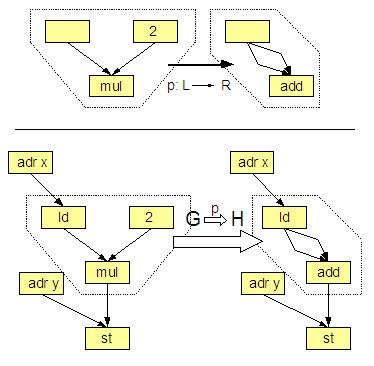 | ||
In computer science, graph transformation, or graph rewriting, concerns the technique of creating a new graph out of an original graph algorithmically. It has numerous applications, ranging from software engineering (software construction and also software verification) to layout algorithms and picture generation.
Contents
- Algebraic approach
- Determinate graph rewriting
- Term graph rewriting
- Classes of graph grammar and graph rewriting system
- Implementations and applications
- References
Graph transformations can be used as a computation abstraction. The basic idea is that the state of a computation can be represented as a graph, further steps in that computation can then be represented as transformation rules on that graph. Such rules consist of an original graph, which is to be matched to a subgraph in the complete state, and a replacing graph, which will replace the matched subgraph.
Formally, a graph rewriting system usually consists of a set of graph rewrite rules of the form
Sometimes graph grammar is used as a synonym for graph rewriting system, especially in the context of formal languages; the different wording is used to emphasize the goal of constructions, like the enumeration of all graphs from some starting graph, i.e. the generation of a graph language – instead of simply transforming a given state (host graph) into a new state.
Algebraic approach
The algebraic approach to graph rewriting is based upon category theory. The algebraic approach is further divided into sub-approaches, the most common of which are the double-pushout (DPO) approach and the single-pushout (SPO) approach. Other sub-approaches include the sesqui-pushout and the pullback approach.
From the perspective of the DPO approach a graph rewriting rule is a pair of morphisms in the category of graphs and graph homomorphisms between them:
In contrast a graph rewriting rule of the SPO approach is a single morphism in the category of labeled multigraphs and partial mappings that preserve the multigraph structure:
There is also another algebraic-like approach to graph rewriting, based mainly on Boolean algebra and an algebra of matrices, called matrix graph grammars.
Determinate graph rewriting
Yet another approach to graph rewriting, known as determinate graph rewriting, came out of logic and database theory. In this approach, graphs are treated as database instances, and rewriting operations as a mechanism for defining queries and views; therefore, all rewriting is required to yield unique results (up to isomorphism), and this is achieved by applying any rewriting rule concurrently throughout the graph, wherever it applies, in such a way that the result is indeed uniquely defined.
Term graph rewriting
Another approach to graph rewriting is term graph rewriting, which involves the processing or transformation of term graphs (also known as abstract semantic graphs) by a set of syntactic rewrite rules.
Term graphs are a prominent topic in programming language research since term graph rewriting rules are capable of formally expressing a compiler's operational semantics. Term graphs are also used as abstract machines capable of modelling chemical and biological computations as well as graphical calculi such as concurrency models. Term graphs can perform automated verification and logical programming since they are well-suited to representing quantified statements in first order logic. Symbolic programming software is another application for term graphs, which are capable of representing and performing computation with abstract algebraic structures such as groups, fields and rings.
The TERMGRAPH conference focuses entirely on research into term graph rewriting and its applications.
Classes of graph grammar and graph rewriting system
Graph rewriting systems naturally group into classes according to the kind of representation of graphs that are used and how the rewrites are expressed. The term graph grammar, otherwise equivalent to graph rewriting system or graph replacement system, is most often used in classifications. Some common types are:
Implementations and applications
Graphs are an expressive, visual and mathematically precise formalism for modelling of objects (entities) linked by relations; objects are represented by nodes and relations between them by edges. Nodes and edges are commonly typed and attributed. Computations are described in this model by changes in the relations between the entities or by attribute changes of the graph elements. They are encoded in graph rewrite/graph transformation rules and executed by graph rewrite systems/graph transformation tools.
